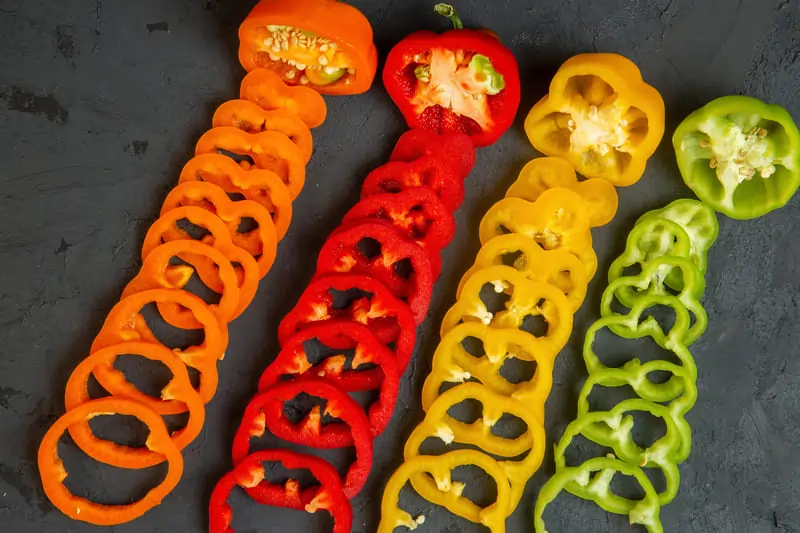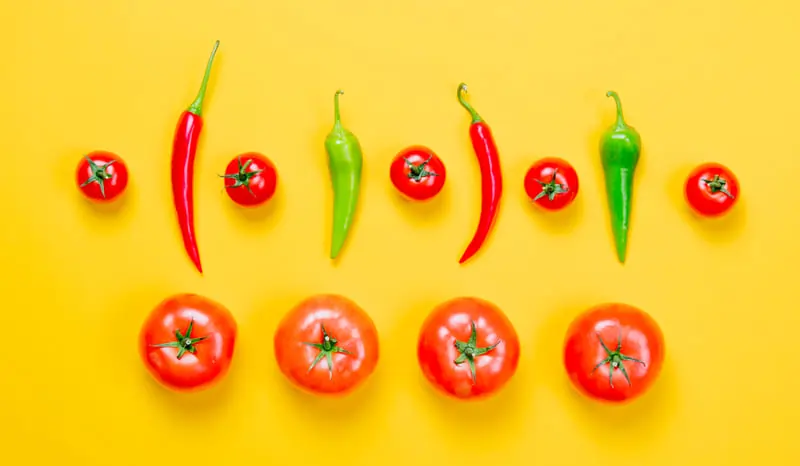Peppers are one of the most diverse ingredients in the culinary world. But how many kinds of pepper are there? With over 50,000 varieties globally, peppers range from the mild sweetness of bell peppers to the intense heat of Carolina Reapers. Understanding these varieties not only adds flavor to your cooking but also enriches your knowledge of this vibrant ingredient.
Understanding how many kinds of peppers are there can enhance both your cooking and gardening experience. For those interested in adding peppers to their home garden, explore this ultimate guide to growing peppers for practical tips.
What Defines a Pepper?
Peppers are vibrant, flavorful fruits that belong to the Capsicum genus, a group of plants celebrated for their versatility in culinary traditions worldwide. These fruits are categorized into two main groups based on their heat levels and flavor profiles, offering something for every palate.
Sweet Peppers for Salads, Stir-Fries, and Stuffed Dishes
- Sweet peppers, such as bell peppers, are known for their mild flavor and crunch. They are often used in recipes like stuffed bell peppers, salads, or stir-fries due to their versatility and vibrant colors. For ideas on preparing these, read Should You Peel Eggplant for Eggplant Parmesan? to explore techniques for enhancing vegetable-based dishes.
- Bell peppers are also an excellent source of vitamins A and C, making them a healthy addition to any meal. Their sweetness intensifies when roasted, adding depth to dishes like roasted pepper soup or fajitas.
Hot Peppers: Jalapeños, Habaneros, and Their Bold Uses
- Hot peppers are celebrated for their fiery kick, brought about by capsaicin, a compound concentrated in the pepper’s seeds and membranes. Varieties range from mildly spicy jalapeños to the intensely hot Carolina Reaper, which holds the Guinness World Record for spiciness.
- Capsaicin offers more than just heat—it’s linked to health benefits like improved metabolism and pain relief. If you enjoy experimenting with bold flavors, try incorporating hot peppers into recipes such as spicy sauces or chutneys. For a different kind of flavorful heat, explore Vegan Eggplant Parmesan: A Wholesome and Delicious Twist, which features bold marinara flavors.
The Scoville Heat Scale
- The Scoville Heat Scale (SHU) is used to measure a pepper’s heat level. For instance:
- Bell Peppers: 0 SHU, entirely mild and ideal for dishes requiring no heat.
- Jalapeños: 2,500–8,000 SHU, adding a gentle spice to salsas and dips.
- Carolina Reaper: Over 2,000,000 SHU, perfect for those who love extreme heat.
Understanding this scale helps in choosing the right pepper for a recipe. For instance, while sweet peppers are ideal for family-friendly dishes, hot peppers add an adventurous element to bold recipes. For additional insights into vegetable preparation, check out What is a Substitute for Eggs in Breading Eggplant?.
Popular Types of Peppers

Peppers come in a variety of flavors, textures, and heat levels, making them a versatile ingredient for countless dishes. Here’s a closer look at some of the most popular types of peppers, along with their characteristics and common uses.
1. Bell Peppers
- Scoville Heat Units: 0 SHU
- Flavor Profile: Known for their sweet, juicy flavor, bell peppers are a favorite for those who prefer mild ingredients. They come in a rainbow of colors, including green, red, yellow, and orange, each offering slightly different flavor nuances.
- Common Uses:
- Sliced raw into salads for a crisp texture.
- Hollowed out and used for stuffed dishes like Classic Stuffed Bell Peppers, which highlight their natural sweetness.
- Stir-fried with other vegetables for a quick and nutritious side dish.
Bell peppers are also rich in vitamin C and antioxidants, making them a healthy and colorful addition to any plate.
2. Jalapeño Peppers
- Scoville Heat Units: 2,500–8,000 SHU
- Flavor Profile: Offering moderate heat with a slightly grassy flavor, jalapeños are one of the most versatile hot peppers.
- Common Uses:
- Chopped into salsas to add a gentle kick.
- Sliced and used to top nachos for added spice and crunch.
- Stuffed with cheese or other fillings for appetizers like jalapeño poppers.
For tips on handling spicy peppers, check out What is a Substitute for Eggs in Breading Eggplant?, which includes techniques for preparing stuffed dishes.
3. Habanero Peppers
- Scoville Heat Units: 100,000–350,000 SHU
- Flavor Profile: Renowned for their fruity heat, habaneros deliver a fiery punch balanced by a tropical sweetness. They’re a go-to pepper for those who enjoy bold flavors.
- Common Uses:
- Blended into hot sauces for a spicy and flavorful condiment.
- Minced and added to marinades for grilled meats and vegetables.
- Infused into dressings to create spicy vinaigrettes.
For a spicy twist on a classic dish, explore this Old-Fashioned Stuffed Bell Peppers Recipe, which can easily be adapted with hotter peppers like jalapeños or habaneros for those seeking extra heat.
Rare and Unique Pepper Varieties
Some pepper varieties are celebrated not only for their flavor and heat but also for their rarity and regional importance. These peppers bring unique characteristics to the table, making them favorites among culinary enthusiasts who love to experiment.
1. Carolina Reaper
- Scoville Heat Units: Over 2,000,000 SHU
- Flavor Profile: The Carolina Reaper holds the Guinness World Record as the hottest pepper in the world. Despite its extreme heat, it has a surprisingly fruity undertone that enhances its versatility in spicy dishes.
- Common Uses:
- Hot sauces: Add just a small amount for a fiery kick that enhances marinades or condiments.
- Chili recipes: For those who enjoy pushing the spice limits, a touch of Carolina Reaper can turn a standard chili into a bold, unforgettable dish.
- When working with this pepper, always wear gloves and handle with care. For more ideas on crafting bold recipes, you can explore Vegan Eggplant Parmesan: A Wholesome and Delicious Twist, which highlights creative flavor pairings.
2. Fatalii
- Scoville Heat Units: 125,000–325,000 SHU
- Flavor Profile: Originating from Central Africa, the Fatalii pepper is renowned for its citrusy heat, which makes it a standout ingredient in both savory and sweet dishes. Its bright lemony flavor pairs beautifully with tropical ingredients like pineapple and mango.
- Common Uses:
- Salsas: Combine with fresh fruits like mango for a sweet and spicy salsa.
- Hot sauces: Infuse its citrusy heat into vinegar-based sauces that pair well with grilled vegetables or seafood.
- Desserts: Add a hint of Fatalii to chocolate truffles for a surprising burst of flavor. For dessert inspirations, visit Banana Bread Cookies: A Perfect Fusion of Two Classic Desserts for ideas that blend unique flavors.
3. Thai Bird’s Eye Pepper
- Scoville Heat Units: 50,000–100,000 SHU
- Flavor Profile: A staple in Asian cuisine, the Thai Bird’s Eye Pepper is cherished for its intense heat and earthy undertones. This small yet mighty pepper packs a punch, often used to elevate curries, soups, and stir-fries.
- Common Uses:
- Curries: Adds a fiery depth to Thai green or red curry.
- Stir-fries: Enhances dishes like pad kra pao (Thai basil stir-fry) with a bold, spicy kick.
- Chili oils: Infuse olive or sesame oil with Bird’s Eye Peppers to drizzle over noodles or dumplings.
For those who enjoy experimenting with global flavors, check out What is a Substitute for Eggs in Breading Eggplant? to explore adaptable techniques for creating unique dishes.
Growing Peppers at Home

Growing peppers at home is both rewarding and practical, as these versatile plants thrive in a variety of conditions and bring vibrant flavors to your kitchen. With the right approach, you can enjoy a bountiful harvest of sweet, spicy, or exotic peppers. Here are some essential tips to ensure success.
Choose Varieties Wisely
- Matching the type of pepper to your region’s climate is crucial for healthy growth. In warmer climates, varieties like jalapeños and habaneros flourish due to their heat tolerance. For cooler areas, bell peppers and Thai Bird’s Eye Peppers tend to perform better.
- Consider experimenting with unique types such as the Carolina Reaper or Fatalii if your conditions are suitable. Learn more about these varieties in Rare and Unique Pepper Varieties for ideas on expanding your garden.
Heirloom Seeds for Flavorful Crops
- Heirloom seeds are an excellent choice for growing peppers, as they are known for producing consistent crops with superior flavor profiles. Unlike hybrids, heirloom peppers often retain the original taste and appearance passed down through generations.
- Varieties such as heirloom bell peppers or heirloom habaneros bring both tradition and robust flavors to your dishes. To incorporate these into your recipes, consider using them in classics like Old-Fashioned Stuffed Bell Peppers.
Care and Maintenance
- Soil Requirements: Peppers thrive in well-drained soil that is rich in organic matter. Adding compost or aged manure can improve the soil’s nutrient content and promote strong growth.
- Sunlight Needs: Place your pepper plants in locations with full sunlight, as they require at least 6-8 hours of direct sun daily.
- Watering Tips: Keep the soil moist but avoid overwatering, which can lead to root rot. Drip irrigation systems or soaker hoses are excellent for maintaining consistent moisture levels.
- Fertilization: Use a balanced fertilizer during the growing season to encourage healthy fruiting. For tips on using natural fertilizers, visit The Ultimate Guide to Making 5-Ingredient Banana Bread, where sustainability practices are highlighted.
Culinary Applications of Peppers: Sweet, Spicy, and Everything in Between
Peppers are a cornerstone ingredient in cuisines worldwide due to their incredible versatility, vibrant colors, and range of flavors. Whether you prefer the mild sweetness of bell peppers or the fiery heat of jalapeños, there are countless ways to incorporate these fruits into your cooking.
Sweet Peppers: A Mild and Versatile Ingredient
- Sweet peppers, such as bell peppers, are a staple in many dishes due to their mild flavor and juicy texture.
- Salads: Add crisp, colorful slices to green or pasta salads for a refreshing crunch. Red, yellow, and orange varieties are especially great for adding a hint of sweetness.
- Stir-Fries: Sautéed bell peppers pair wonderfully with onions and tofu or chicken for a quick, flavorful stir-fry.
- Stuffed Dishes: Hollowed-out bell peppers filled with rice, beans, or ground meat make a hearty and visually appealing main course. For a classic recipe, visit Old-Fashioned Stuffed Bell Peppers.
Hot Peppers: Bold and Spicy Flavors
- Hot peppers, such as jalapeños, habaneros, and Thai Bird’s Eye Peppers, are perfect for dishes that need an extra kick.
- Salsas: Combine diced hot peppers with tomatoes, onions, and cilantro for a zesty salsa that complements chips, tacos, or grilled meats.
- Hot Sauces: Blend hot peppers with vinegar, garlic, and seasonings to create homemade hot sauce that rivals any store-bought version. The Carolina Reaper is a great choice for those who love intense heat. For guidance on handling spicy ingredients, check out What is a Substitute for Eggs in Breading Eggplant?, which includes preparation tips.
- Curries: Incorporate Thai Bird’s Eye Peppers into curries for a deep, spicy flavor that balances beautifully with coconut milk and fresh herbs.
Pickling Peppers: Banana Peppers, Jalapeños, and More
- Pickling peppers like banana peppers, jalapeños, or cherry peppers not only extends their shelf life but also intensifies their flavor.
- Pickled banana peppers make a tangy topping for sandwiches, burgers, and pizzas.
- Pickled jalapeños add a zesty element to nachos, quesadillas, or scrambled eggs.
- For those who enjoy experimenting with homemade snacks, explore Perfect Healthy Snacks for creative ways to incorporate pickled peppers into your diet.
FAQs About Peppers
How Many Kind of Peppers Are There?
Globally, there are over 50,000 varieties of peppers, ranging from mild to extremely hot. These include sweet peppers like bell peppers and intensely hot varieties like ghost peppers and the Carolina Reaper. For a closer look at how peppers can be used in recipes, check out this Old-Fashioned Stuffed Bell Peppers Recipe.
What’s the Hottest Pepper in the World?
The Carolina Reaper holds the title, with a heat level exceeding 2,200,000 SHU. If you’re curious about incorporating milder peppers into everyday cooking, you might enjoy this guide to making 5-ingredient banana bread for an easy pairing with sweet pepper-based sauces.
Can All Peppers Be Eaten Raw?
While sweet peppers like bell peppers are safe to eat raw, extremely hot varieties should be handled with care. If you’re interested in exploring recipes that balance heat with sweetness, consider reading this recipe for banana bread cookies as a healthy snack.

